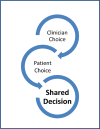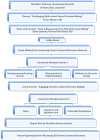The 2016 Academic Emergency Medicine Consensus Conference, Shared Decision Making in the Emergency Department: Development of a Policy-relevant Patient-centered Research Agenda May 10, 2016, New Orleans, LA
- PMID: 27396583
- PMCID: PMC5145753
- DOI: 10.1111/acem.13047
The 2016 Academic Emergency Medicine Consensus Conference, Shared Decision Making in the Emergency Department: Development of a Policy-relevant Patient-centered Research Agenda May 10, 2016, New Orleans, LA
Erratum in
-
Erratum.Acad Emerg Med. 2019 Apr;26(4):462. doi: 10.1111/acem.13701. Epub 2019 Feb 19. Acad Emerg Med. 2019. PMID: 30974018 No abstract available.
Abstract
Shared decision making in emergency medicine has the potential to improve the quality, safety, and outcomes of emergency department (ED) patients. Given that the ED is the gateway to care for patients with a variety of illnesses and injuries and the safety net for patients otherwise unable to access care, shared decision making in the ED is relevant to numerous disciplines and the interests of the United States (U.S.) public. On May 10, 2016 the 16th annual Academic Emergency Medicine (AEM) consensus conference, "Shared Decision Making: Development of a Policy-Relevant Patient-Centered Research Agenda" was held in New Orleans, Louisiana. During this one-day conference clinicians, researchers, policy-makers, patient and caregiver representatives, funding agency representatives, trainees, and content experts across many areas of medicine interacted to define high priority areas for research in 1 of 6 domains: 1) diagnostic testing; 2) policy, 3) dissemination/implementation and education, 4) development and testing of shared decision making approaches and tools in practice, 5) palliative care and geriatrics, and 6) vulnerable populations and limited health literacy. This manuscript describes the current state of shared decision making in the ED context, provides an overview of the conference planning process, the aims of the conference, the focus of each respective breakout session, the roles of patient and caregiver representatives and an overview of the conference agenda. The results of this conference published in this issue of AEM provide an essential summary of the future research priorities for shared decision making to increase quality of care and patient-centered outcomes.
© 2016 by the Society for Academic Emergency Medicine.
Figures
References
-
- Gerteis M. Picker/Commonwealth Program for Patient-Centered Care Through the patient’s eyes: understanding and promoting patient-centered care. 1st. San Francisco: Jossey-Bass; 1993.
-
- Institute of Medicine (U.S.). Committee on Quality of Health Care in America. Crossing the Quality Chasm: A New Health System for the 21st Century. Washington, D.C: National Academy Press; 2001.
-
- Barry MJ, Edgman-Levitan S. Shared decision making–pinnacle of patient-centered care. New Engl J Med. 2012;366:780–1. - PubMed
-
- Mulley AG, Trimble C, Elwyn G. Stop the silent misdiagnosis: patients’ preferences matter. BMJ. 2012;345:e6572. - PubMed
-
- Edwards A, Elwyn G. Shared Decision-Making in Health Care: Achieving Evidence-Based Patient Choice. 2nd. Oxford: Oxford University Press; 2009.
Publication types
MeSH terms
Grants and funding
LinkOut - more resources
Full Text Sources
Other Literature Sources



